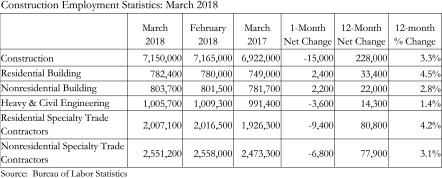
WASHINGTON, D.C. — The U.S. construction industry lost 15,000 jobs on net in March, according to an Associated Builders and Contractors analysis of data from the U.S. Bureau of Labor Statistics. This represents a significant reversal from February, when the industry added a post-recession high of 65,000 net new jobs (upwardly revised from more than 61,000). The construction sector has added 228,000 net new jobs over the past twelve months, which represents a substantial 3.3 percent increase in the number of workers directly employed by the industry.
The nonresidential construction segment lost 8,200 jobs on net in March. While the nonresidential building segment expanded by 2,200 net new jobs in March, nonresidential specialty trade contractors collectively reduced the employment tally by 6,800 positions, and the heavy and civil engineering segment lost 3,600 jobs.
The construction industry unemployment rate, which is available only on a non-seasonally adjusted basis, declined by .4 percentage points and stands at 7.4 percent, 1 percentage point lower than at the same time last year. The national unemployment rate for all industries remained unchanged at 4.1 percent for a sixth consecutive month.
“Every employment report is important. Each time the BLS announces new data regarding employment and unemployment, global stock and bond markets move,” said ABC Chief Economist Anirban Basu. “In recent months, we have been watching for indications of either economic slowing in the form of weaker job creation or overheating or in the form of increasingly rapid worker earnings growth. Today’s jobs report however, is being considered largely in the context of an emerging threat to the economic expansion—a trade war with China.
“The hope had been that the job report today would be strong, indicating that the U.S. economy possesses sufficient momentum to steer through a short, highly symbolic trade war,” said Basu. “Instead, the jobs report was weak, with nonfarm industry payrolls rising by a disappointing 103,000 net new positions. Still, the unemployment rate remained at a low 4.1 percent, which means that the report wasn’t purely negative. Moreover, one month of data tends to be inconclusive regarding the direction of large-scale macroeconomic trends by definition.
“Nonetheless, today’s numbers cannot simply be ignored,” said Basu. “The weak jobs report increases the probability that uncertainty attributable to policy pronouncements emerging from Washington and Beijing can trip up an economic expansion that should be proceeding swimmingly in the context of recently enacted tax reform. For construction firms in particular, the changing news cycle is not helpful. Those who finance construction projects need to be comfortable with the notion that the economy will still be supportive once construction is complete. In other words, the construction industry requires a higher level of stable, persistent confidence to support growth than other industries given the risk that accompanies financing projects and time to build. Confidence is likely dissipating presently.”


 Join our thriving community of 70,000+ superintendents and trade professionals on LinkedIn!
Join our thriving community of 70,000+ superintendents and trade professionals on LinkedIn! Search our job board for your next opportunity, or post an opening within your company.
Search our job board for your next opportunity, or post an opening within your company. Subscribe to our monthly
Construction Superintendent eNewsletter and stay current.
Subscribe to our monthly
Construction Superintendent eNewsletter and stay current.